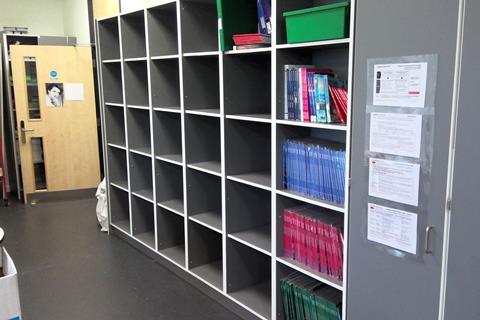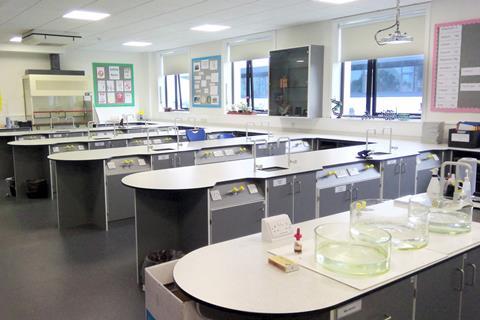Discover why teaching on an island can be very rewarding but also comes with its challenges

Meet Karen and Faye from The Ladies’ College in Guernsey. Karen is head of chemistry and science, and has been teaching for nearly 30 years. She mostly teaches 11–18 chemistry. Faye has been teaching for five years. They teach IGCSE sciences and AQA A-level.
Tell us about your school
Faye: It’s a medium-sized girls’ school on the Channel Island of Guernsey and is 150 years old. There are 400 secondary pupils and 200 infants and juniors. Over the past 15 years, the school has added a sixth form centre, a new art and drama block and, in 2016, Prince Edward came to open the new Wessex wing block. It has stunning views across the channel and is heated with a heat pump. It also has other eco specifications: all lights are on motion sensors so you don’t have to turn them on and off. The science labs have also been upgraded with this feature, along with air conditioning.
How would you describe your classroom set-up?
Faye: Traditional, with the benches in lines coming out from the windows at the side of the room. The teacher has a demonstration bench at the front and a fume hood at the back. We also have an attached prep room.
In the summer of 2021, we moved into a new science lab and we were able to choose the specification, design and colours for it ourselves. A feature that really works well here is cubby holes for the girls’ bags – such a simple idea, but I have never seen a room with them. They’ve really helped to reduce clutter and keep benches clear for practicals. Another new innovative feature is pods on teacher benches. These pods mean we no longer need to worry about logging on and trying to find the right document on the lab computer – you now just plug your laptop in, and the correct page is loaded instantly.
We have been looking at our carbon footprint in chemistry over the past year and come up with all sorts of hacks that drastically cut down on waste. It’s also saved us money. We recycle, reduce and reuse wherever we can.
What makes your teaching spaces unique?

Karen: Our school has invested in becoming a Microsoft Showcase School and a ClassVR Pioneer School, so we have lots of technology hacks. I have taken a course to become a Microsoft Innovation Educator – this is all about smart technology hacks that really make your life so much easier.
Homework involves a mixture of paper and devices, but all the homework is set on Microsoft Teams. We return marks via Teams. Lots of teachers also mark electronically. This all links in with spreadsheets so we don’t have to transfer marks from one place to another.
Covid has hit the schools very badly over here, and it’s not unusual to have only 50% of the students present in a chemistry class. However, if they are well enough, we phone them in using Teams. Girls have a camera pointing to the experiment and the student at home can see what’s happening, and even put the results into the spreadsheet. The phone then gets moved to the front so the student can see everything on the board. Girls will often take a photo of the work written during the lesson and it’s all added to Teams. In this way students at home don’t miss out on any part of the lesson, even the practical. There are a few Teams movies of me demonstrating practicals at the end of lessons, for students not well enough to attend lessons to access later. When I ask students to put their hands up in lessons, I also include the girls at home and ask them questions too.
What are you most proud of?
Karen: The display of the research posters the students completed. We have been working with the Institute for Research in Schools for three years now, and they’ve given us access to some amazing real data. The students wrote up their research in a research poster and presented at the virtual student conference last year. Topics they have researched have involved curating the whipworm genome, looking at family genetics, finding the school carbon footprint, following the melting of Antarctica via live satellite, measuring trees, producing a planting scheme to reduce our carbon emissions and a project making bioplastics which was mainly done during lockdown in students’ kitchens at home.
As it’s hard to get off the island, we need to be a bit self-sufficient when it comes to outreach
We are also very keen on girl power – girls make great scientists and engineers. We hold events on the island that involve all the schools, including International Women in Engineering Day and a student environmental conference. I have also taken groups of girls to do public outreach for the RSC, down on the quayside during public events such as Liberation Day and Seafront Sundays. As it’s hard to get off the island, we need to be a bit self-sufficient when it comes to outreach.

Tell us about the practicalities of teaching on a small island.
Karen: It has its good bits, but it can also be frustrating. The good bits: everyone works together, and you know everyone. The politicians are very approachable and organisations on the island work together to educate all young people, regardless of what schools they go to.
Increasingly, since Brexit, we’ve had problems with some of the big chemical suppliers no longer delivering to the Channel Islands. Although our school still has contracts for specialists to service fume cupboards and water, it’s not cheap and involves the cost of a return airfare.
Being on a small island also meant it recently took the school two years to get rid of spent radioactivity. Due to the paperwork involved, the whole island had to work together to bring someone over and collect it all. The technicians from all the schools here generally know each other, and are happy to help each other out with supplies or things that have run out.
Another challenge is taking students to events such as the Big Bang, Teen Tech and even just science lectures – going to free events can become massively expensive, as it always involves an overnight stay. We try and get people over to talk but, again, it involves a flight, accommodation and food. And there’s always a risk that we will be fogged in, or the boat won’t go due to the weather. So with any trip planning, we must always have insurance in place for when you can’t get off the island and therefore can’t go.

What would you do with an unlimited budget for your classroom?
Karen: I would love a virtual display like a hologram that students could walk into. You can get 3D goggles to do this, but I would want us all to be there together. I could teach inside the virtual hologram, and anything could happen. We wouldn’t even have to worry about gravity! You could rotate molecules and see their shape. And balancing a chemical equation would be exciting. This would have a very low carbon footprint because, apart from some electricity to power it, nothing else would be real. I also think that visual and kinesthetic ways of teaching with hacks that aid memory really help students learn science more effectively.
Want to see your science department on the pages of EiC? Email education@rsc.org with In my classroom as the subject line.
Show us your classroom and lab
Want to share your teaching space? Then email us and your favourite space or display could feature in EiC online and in print.









No comments yet